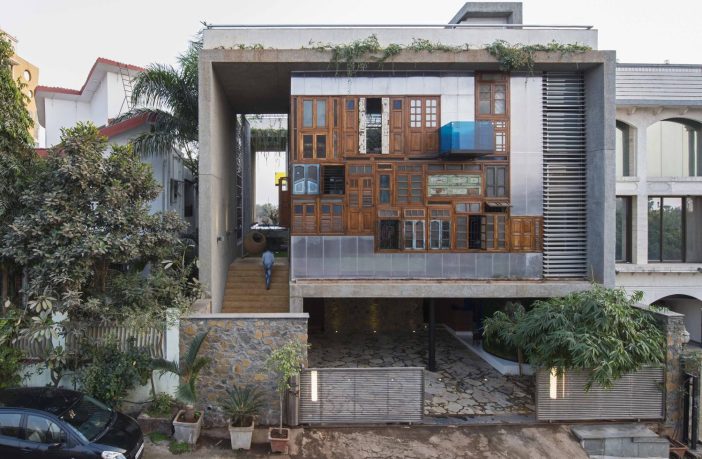- Reform and adaptation of spaces represent a significant parcel of projects ordered to architecture firms, and reuse of preexisting structures is not newness.
- Functions and needs change over time, therefore adaptations are required to meet new demands.
- However, no matter how much the maintenance of a building is, in most cases, preferred in economic and ecological sense to its demolition and a new construction from the beginning, the logic of the reuse of a space does not usually extend to its parts that become, thus, rubble
In 2019, the civil construction sector, responsible for 38% of global CO2 emissions from materials, constructions and construction operations – reached its historical maximum, according to the 2020 Global Status Report for Buildings and Construction. Data hold off the fulfillment of international agreements aimed at reducing pollutant emissions, also reaffirm their key and strategic role in this challenge of global scale, threatening the construction model as it is practiced today.
In the constructive sector, the linear economy model, used from production to the disposal of materials, could be easily schematized in the stages of extraction, production, construction, use and disposal. This model reveals a non-specific problem that goes far beyond the manufacturing stage of constructive materials, also involving its final destination. In demolition processes, when the parts of the construction no longer meet the needs to which they were thought to be fulfilled, they are destroyed and transformed into rubble. In order to fulfill tight schedules and streamline the work process, demolition has been the rule for a large part of remodeling projects, eliminating the possibility of reuse from its constructive elements and materials.

Considering a context in which approximately 2/3 of the existing buildings area today will continue to exist by 2040, adding to the fact that the reforms have shown to be the specialty of the architects of the future, the model of processing of constructed spaces should not be a matter to be ignored. It is necessary to review the form of acting in the constructive sector as a whole and convert the linear use of materials to a circular model: it is necessary to stop demolishing and begin to disassemble.

The impact of use, for the same purpose, construction materials from reuse, can be 2 to 12 times lower than the use of new state equivalents, according to Life Cycle Assessment (LCA). In addition to reducing the disposal generated in the construction and demolition and expenses and emissions related to the treatment of these waste (such as recycling or incineration), disassembly encourages labor and local construction knowledge, preserving cultural values intrinsic to preexisting buildings.
In this sense, disassembly reveals a constant learning process – even when the reuse of parts of construction is not feasible. To disassemble the elements of a building, whether they doors, windows, panels or benches, you need to understand how your facilities have been thought, that is, dis-assemble.

Bricks, coatings and other materials set with the use of mortar require longer disassembly and, depending on the situation, may not be feasible and / or profitable. Therefore, even if the demolition is in fact the final destination of a building – from the demolition of constructive elements to the demolition of the whole building – the establishment of a schedule and the analysis of the best to take advantage of construction parts before the demolition are necessary.
In order to make the reuse of construction elements more accessible, in recent years there have been a number of initiatives and companies dedicated to the reuse of building materials, operating from the disassembly itself to the commercialization of construction parts from preexisms, offering a series of services to encourage a change in the construction model as we know today.

This is what has been shown by Arquivo, a company and Think-tank founded by architects Natália Lessa and Pedro Alban in Salvador (Brazil). With the mission of simplifying material reuse, Aqruivo offers services such as physical removal of reusable materials, sale of reuse elements, consulting and project assistance, in addition to conducting a survey focused on the possibilities of reuse in the Brazilian context required Establish a “Functional Reuse Industry on National Scale – necessarily composed of other actors beyond Arquivo,” as described on their website.

The so-called “actors” of the circular economy go beyond expert companies in reuse and include from junk yards to architects, designers and engineers. Although often the material reuse movement already exists without the need for an experienced company in the area, when acting on its own, these actors usually find certain difficulties in operations. Thus, companies specializing in the reuse of building materials in different stages work as facilitators of the process and, in this sense, Arquivo stands out as a pioneer in the Brazilian context.

In the same direction, Rotor DC, a Belgian cooperative established in 2014, has been working in order to arrange the reuse of construction materials in disassembly and marketing, as well as collaborating with government entities in the elaboration of guides and regulations to encourage reuse as a practice in architecture, such as the Handbook for Reuse off Site and the Guide for Identifying the Reuse Potential of Construction Products.

The network of companies and initiatives linked to the reuse of construction materials has grown in recent years and points to a more promissory future regarding disassembling and reusing as recurring practices in architecture. But in addition to this movement, it is also necessary to encourage and regulate practice through, for example, evaluation forms for the possibility of reuse of parts of construction before the work; certifications for projects that reuse building materials; and promotion of tax credits, seeking to reduce the cost difference between demolitions and dismantling – although reuse materials present a significantly lower cost than those new, the cost of labor in deconstructions is higher than in demolitions.

Finally, if disassembly is a viable option for demolition (or to reduce the debris generated by it), it is also necessary to think about how to make it easier from the beginning of the project, taking special care in joining the materials and in the preference by mechanical fittings and fastenings, as defended by the concept of Design for Disassembly (DfD) — “design to disassemble”. Thinking and acting at all stages of the cycle is the way to reverse the one-way logic of consumption-disposal and promote a circular economy.
As a method to preserve not only the construction parts themselves, but also a constructive way of acting, the dismantling of these elements, rather than demolition, points to new possibilities for reinterpreting construction based on deconstruction. This movement, beyond the building’s scale, contributes to significant and necessary changes in the linear building model.
Author: Susanna Moreira | Translated by Diogo Simões
This article was first published in ArchDaily and is republished with permission.













